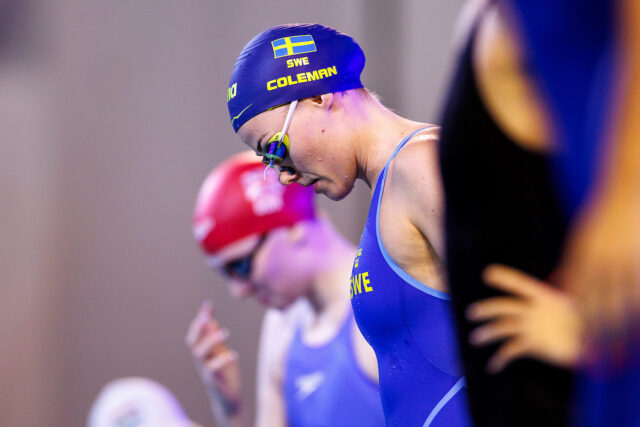By Olivier Poirier-Leroy on SwimSwam

Feeling stuck with your dryland? Here’s how combining resisted swimming with dryland can boost performance in the pool.
Dryland is one of the more confounding parts of our sport.
On the one hand, getting stronger and fitter on land should *obviously* make us faster.
On the other, dryland can backfire, creating competing adaptations that crater swim performance or worse, lead to injury.
A five-year analysis of NCAA swimmers found that nearly 40% of all injuries occurred during dryland training. (Not ideal.)
So what separates the kind of dryland that helps swimmers go boom-boom in the pool from the kind that just leaves us sore and sluggish in the water?
It comes down to this: A winning dryland program doesn’t just create strength in the gym, it creates strength in the context of your swimming.
Let’s dive into that.
The Winning Dryland Combo
A meta-analysis by Wang et al. (2025) examined the effectiveness of different dryland modalities on swimming performance. Researchers analyzed 36 randomized trials involving a total of 844 competitive swimmers.
The big winner?
 Combining resisted swimming and resistance training on land.
Combining resisted swimming and resistance training on land.
This combination of resisted swimming (i.e. drag chute, resistance tubing) and resistance training on land (i.e. squats, bench press) crushed it:
- 50 and 100m performance improved the most of all training types
- Swim velocity increased significantly
- And stroke rate jumped, too
Swimmers got stronger in the gym, applied that strength in the specific context of resisted swimming, and swim performance followed.
Why this Combo Works
One of the benefits of dryland training is that we can overload muscles with weights, medicine balls, and gravity far beyond what we can generate in the pool. Under the barbell, we can better build heaps of raw strength and power—more than we could ever hope to do when swimming.
In the water, we apply that strength under the same patterns, drag forces, and joint angles we experience when racing.
- Build strength in the gym -> Apply strength to resisted swimming -> Convert into real swim speed
This 1-2-3 punch improves our ability to coordinate that newly made strength and power in the exact environment where it matters most…
In the pool and on the clock.
The Problem with “Swim Specific” Dryland
One of the biggest myths of dryland is that it needs to be “swim specific” to be effective.
And so swimmers/coaches will load movements that approximate full-stroke swimming on the pool deck or in the gym (i.e. doing freestyle arm strokes with dumbbells). It may look specific, but it doesn’t build the kind of raw strength you get from compound lifts.
- See also: How to Improve Sprint Freestyle Speed
Dryland isn’t about copying the movement of your swim stroke. It’s about building large deposits of strength, power and coordination, and then learning to apply those qualities in the water.
You build the foundation by loading large muscle groups through full ranges of motion with squats, pulls, presses, and jumps.
Once that base is built, you connect it to the pool through resisted swimming (parachutes, chutes, cords, or power towers), teaching your body how to turn that new strength into swimming awesomeness.
How to Make This Combo Work
Here are some tips for implementing this dryland + swim training model like a pro:
- Hit the big lifts in the gym. Focus on compound movements that recruit major muscle groups. Squats, bench press, pull-ups. Aim for near-max (80-90% of 1RM) loads to build real strength.
- Add resisted swim training. Go short and go intense. 15-25m sprints with full rest. The goal is power, not slow, sluggish swimming. There are a lot of benefits of resisted swimming, but it works best when it’s short and powerful.
- Don’t overdo it. Swimmers are natural workhorses, which means that if we find something that works, we tend to promptly go overboard. Studies with swimmers (i.e. Girold et al., 2006) found that just 2-3x combined sessions of this type of per week were enough to see major gains. Rest is essential to make this work.
The Bottom Line
At the end of the day, dryland training isn’t about mimicking swimming, but creating the stability, strength and power that amplifies what you are doing in the water.
By combining well-structured dryland workouts with resisted swimming, you get the best of both worlds.
So hit the gym. Get those gains.
But pair it with targeted resisted swimming in the pool.
And get those swim gains, too.
ABOUT OLIVIER POIRIER-LEROY
 Olivier Poirier-Leroy is a former national level swimmer, 2x Olympic Trials qualifier, and author of several books for swimmers, including YourSwimBook, Conquer the Pool, The Dolphin Kick Manual, and most recently, The 50 Freestyle Blueprint.
Olivier Poirier-Leroy is a former national level swimmer, 2x Olympic Trials qualifier, and author of several books for swimmers, including YourSwimBook, Conquer the Pool, The Dolphin Kick Manual, and most recently, The 50 Freestyle Blueprint.
The book is a beastly 220+ pages of evidence-based insights and practical tips for improving freestyle sprint speed.
It details everything from how to master stroke rate, the specifics of sprint technique, how to build a thundering freestyle kick, improve your start and underwaters, and much more.
The 50 Freestyle Blueprint also includes 20 sprint sets to get you started and a bonus guide on how to master the 100 freestyle to complete your sprint preparation toolkit.
 Learn more about The 50 Freestyle Guide today.
Learn more about The 50 Freestyle Guide today.
Read the full story on SwimSwam: The Dryland Combo That Turns Strength into Speed


